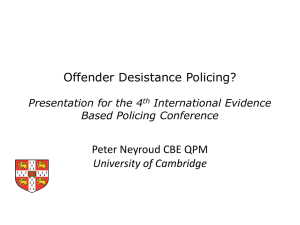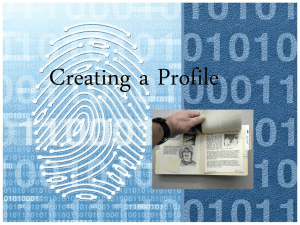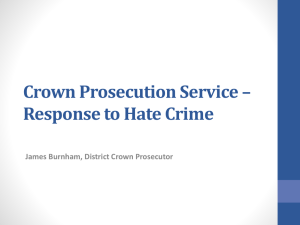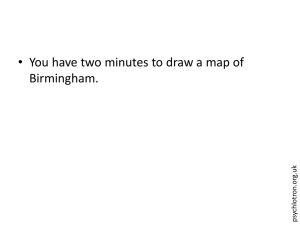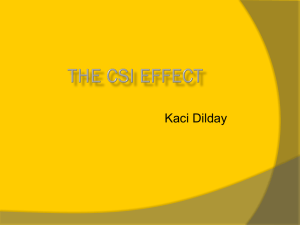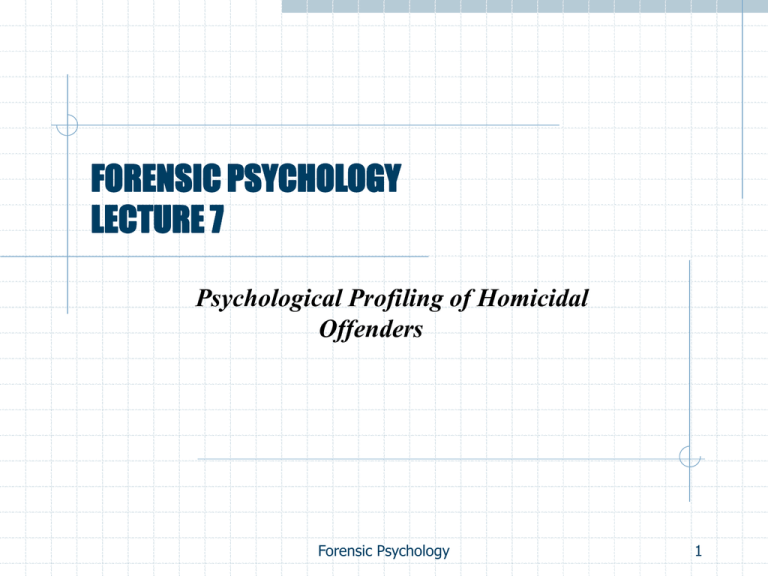
FORENSIC PSYCHOLOGY
LECTURE 7
Psychological Profiling of Homicidal
Offenders
Forensic Psychology
1
Motivational Spectrum of Homicide
REVITCH AND SCHLESINGER (1989) – (See Article Handout)
Spectrum of Motivational Stimuli - based on clinical experience
rather than empirical research.
The Catathymic Crisis – Schlesinger (1996) – Article
Howitt, Dennis. (2009), Introduction to Forensic and Criminal
Psychology: 3rd Edition. London: Pearson Prentice Hall –
Chapter 14 & 15.
Forensic Psychology
2
Origins of Psychological Profiling
1886 - Jack the Ripper – Dr. Bond
Physical Strength, no accomplice, respectable, neatly dressed,
solitary habits, no full time employment.
1956 – George Metsky “New York Bomber” – Dr. Brussel
Male, heavy, middle aged, single, living with a sibling.
Modern Profiling
FBI Classification
Geographical Profiling (Canter)
Forensic Psychology
3
Psychological Profiling
Psychological Profiling of Homicidal Offenders involves the
investigative aspects of forensic work, including work on crime
detection and offender profiling. It involves various
psychological profiles, different levels of motivation and different
prognoses of homicide.
Behavioural and psychological evidence of the offender can be
gained from assessment of the crime scene. Crime scenes that
are disorganised/organised in appearance can actually give the
police an insight into the personality of the offender.
Forensic Psychology
4
Psychological Profiling
The goal of creating a profile is to gain an idea of the physical,
behavioural and demographic characteristics of the offender,
what his behaviour is likely to be after committing the crime and
when he might strike again. The profile may also provide useful
information for interrogation methods after the offender is
identified and apprehended.
(Keppel and Birnes, 2003).
Jackson and Bekerian (1997) believe that profiling will only
become completely successful when “there is a direct
interaction between basic theoretical hypotheses and the
applied domain.
Forensic Psychology
5
Psychological Profiling
Crime Scene Profiling uses information from the scene of the
crime (physical and other evidence) to generate a picture of the
unknown offender.
Psychological Profiling uses standard personality tests and
interviewing to assess the extent to which the individual fits the
known personality template of a certain type of offender.
Offender Profiling is the collection of empirical data in order to
collate a picture of the characteristics of those involved in a
certain type of crime.
Homant and Kennedy (1998)
Forensic Psychology
6
Crime Scene Assessment
What Do the Police Look for?
Chief Constable Atcherly – (1896) - Categories for MO of
Offender
(Location, Entry, Time, Style, Confederates, Transport,
Trademark)
Who?
What?
Where?
Why?
Behaviour reflects Personality (Douglas)
Forensic Psychology
7
Classification of Murderers
Patterns of Murderers: Organised Vs. Disorganised (Nonsocial
vs. Asocial)
Ressler et al. Article (1986) Sexual Killers and their Victims
Schlesinger (2000)
Douglas (1980), (Hazelwood & Douglas et al., 1986)
Schlesinger categorises Organised and Disorganised offenders
according to:
Crime scene characteristics
Personality characteristics
Forensic Psychology
8
Common Terms
Modus Operandi – the operating technique used by the offender.
The actions necessary to commit murder.
Signature – The signature is often referred to as the “calling card”
of the offender. The person goes beyond what is necessary to
commit the crime, i.e. burglarise and defecate home, stab a
number of times.
Staging – Altering the crime scene to throw the investigation, this
may happen with organised offenders.
Undoing – Undoing usually takes place when there is a close
relationship between the victim and offender.
Forensic Psychology
9
Common Terms
Concept of Escalation
The concept of escalation involves an increase in the intensity of
criminal behaviour. Crimes start at a minor level and progress
to worsening levels. Burglary is often correlated with murder.
Forensic Psychology
10
Classification of Offenders
ORGANISED
DISORGANISED
VICTIMS
Wives and girlfriends
safe – gets more pleasure
from killing than sex
with wives and
girlfriends – Single
White Female.
Anybody – very poor
relations with women in
general. Usually live
alone.
CRIME SCENE
Crime scene staged, and
transport body
No staging, leave body
where killed.
WEAPON
May carry weapon with
him, and take them away
after the crime, i.e. rape
kits
Uses weapon of
opportunity, frenzied
attack, often
depersonalizes the
victim, i.e. turn them on
their stomachs
Forensic Psychology
11
Classification of Offenders
ORGANISED
DISORGANISED
CHILDHOOD
Troublemaker at school.
Classmates won’t
remember the offender.
PERSONALITY
Externalize anger, often
attractive, confident,
intelligent, good verbal
skills. History of
problems with authority.
Internalise anger,
physically unattractive,
low self-esteem, and
previous suicide attempts,
not very articulate in
conversation.
RELATIONSHIPS WITH
WOMEN
Talks to women, mood is
fairly controlled.
Doesn’t often talk to
women, mood is anxious
Forensic Psychology
12
Classification of Offenders
ORGANISED
DISORGANISED
PLACE OF
RESIDENCE
Live some distance from the
crime, except the first crime,
as it is close to home and more
comfortable. Usually live
with a woman.
Kills where there is
familiarity, usually close to
home or to work. Lives
alone.
PRE-OFFENCE
May be precipitated by loss of
job or break-up with partner.
Low self-esteem comes on
victim of opportunity.
PUBLICITY
Takes interest in media reports
of crime, will often try to get
involved with the police
investigation
No interest in media reports
of crime.
Forensic Psychology
13
Mixed Crime Scenes
Most crime scenes are mixed in nature as
The organised offender may have been interrupted.
There may be more than one offender, patterns are different at the
crime scene.
Primary motive may have been rape, but murder may have resulted in
disorganised offender.
Reaction from victim may not have been anticipated, and the offender
may not have been able to control the victim.
Organised offenders may become disorganised after a spree of killings.
Alcohol or drugs may have had an effect.
Offenders themselves may have mixed patterns of behaviour.
Forensic Psychology
14
Factors that should be considered
Crime Assessment Stage
Reconstruct in your mind what went on – was it planned or
sudden action, weapon is important for assessment – “weapon of
opportunity” demonstrates
no planning- weapon of choice
demonstrates some planning.
Staging – Does the offender try to make it look like something
else?
Positioning of body – important, location of excessive trauma.
Forensic Psychology
15
Factors that should be considered
Time Factors
What time of day did the murder take place?
Mornings might attribute to a character that is unemployed/shift
worker. How long did the offender spend with the victim? – The
longer the time, the greater the risk of being apprehended.
Location Factors
Where was the victim apprehended?
Was she persuaded to go elsewhere?
Where was the person found? (Was the body moved? – has the
person a means of transport?)
Is it likely that the victim or offender has some familiarity with
the place?
Forensic Psychology
16
Conducting A Profile
1) Get facts of the crime (behaviour, what he did and the crime scene).
2) Background information on the victim/offender.
3) Autopsy report.
4) Behavioural information at the scene.
5) Type of murder
Consider profiles are used in conjunction with so many other crime solving
methods
Consider victim risk and offender risk
Consider the usefulness of psychological profiling
Forensic Psychology
17




